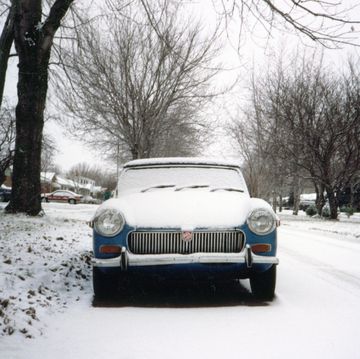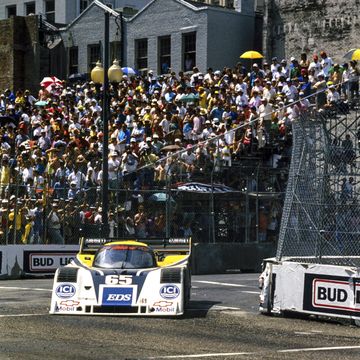Okay, at first blush, this seems kind of like a meaningless publicity stunt: TV star and multiple People Magazine "Sexiest Men Alive" honoree Idris Elba hops into a brand-new, immensely powerful super-coupe and obliterates a speed record set when George V was still king and Charles Lindbergh had just landed in Paris.
If it seems silly, it's because this was not in any way a fair fight. Look, Idris Elba is a certified badass, but the 626-hp Bentley Continental GT Speed he was driving benefits from 88 years of automotive evolution that Sir Malcolm Campbell absolutely didn't have at his disposal back in 1927. That's a sizable advantage in favor of the British star.
Stick with us here, though, because there's a very cool parallel to all of this, and it's something that even Bentley didn't think to highlight.
See, if you read Bentley's press release, it lays out the bare facts: The undeniably attractive Elba, star of Luther and The Wire, sought to break the "Flying Mile" record, a top speed run that takes place on a seven-mile stretch of smooth, firm beach on the shores of Carmathen Bay, Wales, known as Pendine Sands. The defending champion of the Flying Mile was Sir Malcolm Campbell, whose two-way average of 174.8 mph has gone unchallenged since 1927.
Elba in the GT Speed obliterated that, blasting through the one-mile stretch at a maximum velocity of 180.361 mph. You can see how overjoyed he was.
But why did it take 88 years for Sir Malcolm's record to fall? For that, we need to dig into the history of Pendine Sands.
In the early 1900s, when the pioneers of motor racing first sought glory in the form of maximum velocity, standard roads and race tracks soon became inadequate. As daring record-breakers pushed 150 mph, they needed a venue that offered enough space on either side of the measured mile to safely run at top speeds. The seven-mile stretch of Pendine Sands fit the bill perfectly.
Sir Malcolm was the first to set a flying mile record at Pendine Sands, with a 1924 run that set the bar at 146.16 mph. The record didn't stand long: Sir Malcolm and Welshman J.G. Parry-Thomas each held the top speed two more times between 1924 and 1927. Sir Malcolm set a new record in February 1927 with a speed of 174.22 mph; The next month, Parry-Thomas suffered a fatal crash at Pendine Sands when his car went out of control at an estimated 170 mph. He was the first of many drivers to die while pursuing a speed record.
After Parry-Thomas's death, and another unsuccessful challenge in 1927 by Giulio Foresti (who miraculously walked away after his car rolled at an estimated 150 mph), land speed record seekers sought out other venues. Eventually, drivers gravitated to the wide open expanses of Daytona Beach and the Bonneville Salt Flats, though Sir Malcolm set a 246.09 mph record in Verneuk Pan, South Africa in 1931 that stood for more than a year. Pendine Sands was taken over by Britain's Ministry of Defense in WWII, with public vehicle use on the beach banned until 2010.
So while the land speed record rose higher and higher, topping out with Andy Green's ThrustSSC run of 760.343 mph in 1997, the record at Pendine Sands remained a remarkable but no longer world-beating 174.8 mph.
Yes, it's entirely safe to assume that Bentley and Elba sought out a record they knew the Continental GT Speed could break. By a quirk of history, Pendine Sands provided just such a record—with the added benefit of being in Great Britain. British car, British star, British sands; it's almost enough to make you hum "God Save the Queen."
Here's where history left a nice little bit of coincidence, though: The car that Sir Malcolm Campbell used to set that long-standing 1927 record was the Napier-Campbell Blue Bird, a gargantuan open-cockpit streamliner that was the second in a long succession of speedsters named Blue Bird. The Napier aspect of the name came from the Blue Bird's engine, a 12-cylinder aircraft motor that was once the most powerful engine in the world. The Napier's cylinders are arranged in three banks of four cylinders set apart at 60 degree angles—in other words, a W-12.
Idris Elba's Bentley is also powered by a W-12, albeit one with a different cylinder arrangement (two 15-degree V-6 engines sharing a crankshaft with a 72-degree spread between them). Which means that, when Elba put the hammer down, he deposed a W-12 with another W-12.
Just a nice little bit of history repeating itself.

Bob Sorokanich previously served as deputy editor of Road & Track Magazine. He is based in New York City.














